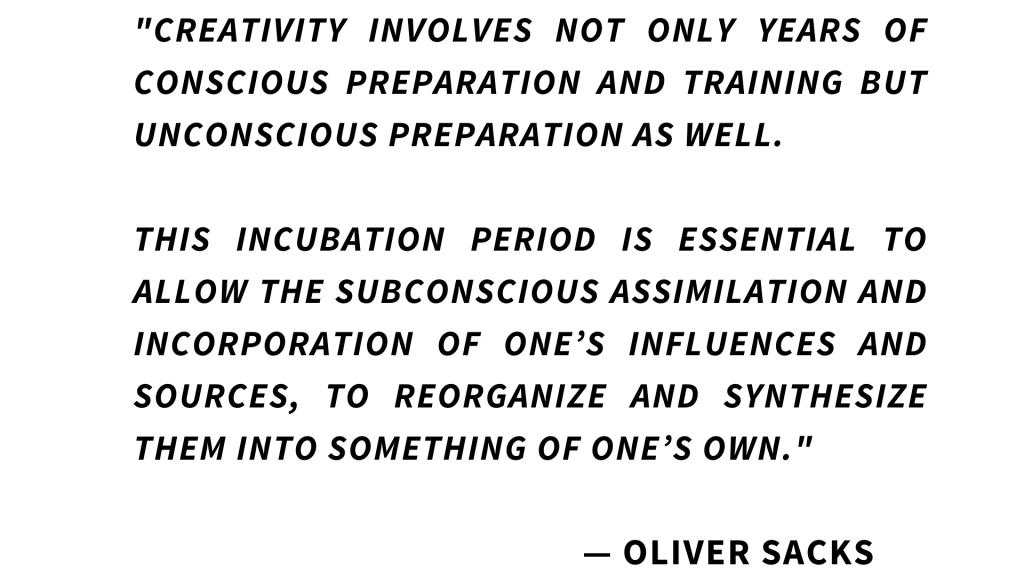The following is an excerpt from Guy Tal’s The Interior Landscape

Anyone involved in creative endeavors likely is familiar with creative blocks—times when creative ideas fail persistently to materialize for prolonged periods. When the creative well runs dry, we often become anxious and seek reassurances, we remind ourselves of the inevitability of blocks, their transitory nature, perhaps even of times when creativity returned with renewed vigor after such episodes. We look for tips and strategies to break the block, we try to force ourselves to work despite the malaise, we wish for things to go back to the way they were. Still, as the days turn to weeks or months, anxiety and doubt keep building. Will this time be an exception?
There’s another way to think about creative blocks: not as hindrances to creativity but as harbingers of creative renewals, as necessary breaks for the mind to replenish its creative resources, to clean house, to organize and assimilate new ideas and information.
Psychologist Eric Maisel speculated that to a creative person, creating is a way of making meaning. When we are not productive, according to Maisel, we lose our sense of meaning and spiral into depression. In his book The Van Gogh Blues, Maisel wrote, “This is why creating is such a crucial activity in the life of a creator: It is one of the ways, and often the most important way, that she manages to make life feel meaningful. Not creating is depressing because she is not making meaning when she is not creating.” I think Maisel’s point is true regarding creativity, but I also think it’s worthwhile to point out a common misconception, which is this: to be creative is not the same thing as to be productive.

A creative product may (or may not) be the outcome of “creating,” but a person may be creating, in the sense of being engaged in a creative activity, for prolonged periods before arriving at an idea that may lead to any tangible outcome. As it turns out, some of the brain processes involved in giving rise to creative ideas are not conscious. The phase of subconscious processing, before an idea or a solution comes to mind, is known as incubation. When incubating, creators may be “creating” without even knowing they are engaged in creative thinking. Even when doing other things. Even when asleep. These periods of incubation, therefore, are easy to confuse for creative blocks.
I am no stranger to creative highs: the experience of flow when immersed in creative work, the “aha!” moment of revelation or discovery when an exciting idea comes to mind, the sense of accomplishment and pride when creating a satisfying photograph, an article, or a book. The more original and personally significant the work, the greater the satisfaction, and the more energized I feel afterward to tackle my next challenge. Still, the reverse is not true: I don’t feel that my life has lost meaning when I am not productive.
Some of my most meaningful experiences involve the assimilation of various dimensions of my experience—sensations, contemplations, awe, beauty—leading to intense emotions, sometimes to ideas whose usefulness may not be immediately apparent, and that are not ostensibly associated with any product. Such experiences may still count as creative if feeding into the subconscious parts of creative thinking, which for me are constant by virtue of the fact that I strive constantly to live a creative life: to shape my attitude toward and engagement with the world by constantly seeking and aspiring to discoveries, new ideas, and new knowledge. There is no doubt in my mind that these are essential to the conception of future creative expressions, even if I may not know what they are or apply any conscious effort toward them at a given time.
Certainly, those indoctrinated into associating such things as duty and self worth with work may instinctively associate lack of productivity with such feelings as shame and distress. This is unfortunate. Susan Sontag observed this effect among photographers, writing, “Using a camera appeases the anxiety which the work‑driven feel about not working when they are on vacation and supposed to be having fun. They have something to do that is like a friendly imitation of work: they can take pictures.” Bertrand Russell, in an essay titled “In Praise of Idleness,” wrote, “A great deal of harm is being done in the modern world by belief in the virtuousness of work.”
When it comes to creative work, creativity—incubation and all—must precede work. As Timothy Egan put it in a New York Times opinion piece, “Creativity comes from time off, and time out.” It is good for artists feeling blocked to remind ourselves that what we may perceive as a creative block is perhaps better described as a productivity block. Our creative faculties most likely are intact, perhaps even working subconsciously on new ideas, even if at any given time we may fail to come up with actionable ideas. It is also true, however, that work involving states of flow—even if not outright creative—often begets creative ideas by suppressing distractions and anxiety. This may suggest that one way to get through creative blocks is to work through them—clean the studio, do yard work, study, tend to accounting or other uncreative demands. In doing so, we may free up cognitive resources for those parts of our subconscious mind engaged in whatever it is they do while incubating new ideas. As psychologist Adam Grant put it, “It’s only when you’re told that you’re going to be working on this problem, and then you start procrastinating, but the task is still active in the back of your mind, that you start to incubate. Procrastination gives you time to consider divergent ideas, to think in nonlinear ways, to make unexpected leaps.”
Creative blocks, when they are short-lived, can be unpleasant, and often lead to a sense of relief when productivity and the flow of ideas return to their normal levels. Still, I think that there is something unique about notoriously persistent blocks—those that refuse to yield, for weeks or months. I believe that such blocks generally accompany significant change in one’s life, especially for artists committed to self-expression in their work. When the self—the person—changes, former styles and methods that may have been expressive of the person one was may no longer express the person one has become. It may be that these prolonged and difficult blocks, in fact, are indicative of the subconscious mind exploring new ways to assimilate changes in personality, outlook, lifestyle, or philosophy. It’s no longer about finding creative ways to express what one already knows how to express but about adapting to new knowledge, which by necessity takes longer and may be contingent on rare moments of insight before resolving itself.
My advice to anyone in the throes of a prolonged creative block is this: Before attempting to stem the block, first cut yourself some slack. Meditate on changes in your life, open your mind to novel ideas, make yourself comfortable with letting go of older formulas that may no longer satisfy, and with accepting that your subconscious mind may be telling you it’s time to try something new that you may not yet know how to do. Most important, don’t make an already vexing situation worse by interpreting what may ultimately be a necessary phase of incubation and creative growth as any indication of diminished self-worth, or as reason for self-flagellation.
As psychologists like to say, give yourself permission to use this time to rest and renew, to explore possibilities, to indulge. If the time has come, not just for new work but for new ideas, epiphanies, directions, or style, don’t stand in your own way. Give it time. Let the creative circuitry in your brain do what it needs to do to adapt and to conceive new ways of thinking and producing work.
Anecdotally, one means of grappling with a creative block that has often worked for me is to write about creative blocks—to dredge from my mind what I know and what I have experienced regarding creative blocks. If nothing else, it helps keep things in perspective and to regain the confidence that, as the adage goes, “this too shall pass.”
